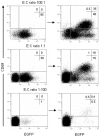Lymphocyte display: a novel antibody selection platform based on T cell activation
- PMID: 19777065
- PMCID: PMC2747005
- DOI: 10.1371/journal.pone.0007174
Lymphocyte display: a novel antibody selection platform based on T cell activation
Abstract
Since their onset, display technologies have proven useful for the selection of antibodies against a variety of targets; however, most of the antibodies selected with the currently available platforms need to be further modified for their use in humans, and are restricted to accessible antigens. Furthermore, these platforms are not well suited for in vivo selections. We present here a novel cell based antibody display platform, which takes advantage of the functional capabilities of T lymphocytes. The display of antibodies on the surface of T lymphocytes, as a part of a chimeric-immune receptor (CIR) mediating signaling, may ideally link the antigen-antibody interaction to a demonstrable change in T cell phenotype, due to subsequent expression of the early T cell activation marker CD69. In this proof-of-concept, an in vitro selection was carried out using a human T cell line lentiviral-transduced to express a tumor-specific CIR on the surface, against a human tumor cell line expressing the carcinoembryonic antigen. Based on an effective interaction between the CIR and the tumor antigen, we demonstrated that combining CIR-mediated activation with FACS sorting of CD69(+) T cells, it is possible to isolate binders to tumor specific cell surface antigen, with an enrichment factor of at least 10(3)-fold after two rounds, resulting in a homogeneous population of T cells expressing tumor-specific CIRs.
Conflict of interest statement
Figures








References
-
- Smith GP. Filamentous fusion phage: novel expression vectors that display cloned antigens on the virion surface. Science. 1985;14;228 (4705):1315–1317. - PubMed
-
- Winter G, Griffiths AD, Hawkins RE, Hoogenboom HR. Making antibodies by phage display technology. Annu Rev Immunol. 1994;12:433–455. - PubMed
-
- Hoogenboom HR. Selecting and screening recombinant antibody libraries. Nat Biotechnol. 2005;23:1105–1116. - PubMed
-
- Buchholz CJ, Peng KW, Morling FJ, Zhang J, Cosset FL, et al. In vivo selection of protease cleavage sites from retrovirus display libraries. Nat Biotechnol. 1998;16:951–954. - PubMed
Publication types
MeSH terms
Substances
LinkOut - more resources
Full Text Sources
Other Literature Sources

